Abstract
1. Changes of rectal and ear temperatures, and respiratory and heart rates, during external thermal stress and during thermal displacement of the medulla oblongata and spinal cord have been investigated in rabbits, before and after decerebration, with ether inhalation only during the operation.
2. Abrupt exposure of the intact animals to heat (35° C) or cold (5° C) produced appropriate thermoregulatory adjustments such as vasodilatation or vasoconstriction of the ear skin, and increase or decrease of respiratory frequency with little change in rectal temperature. After decerebration, these responses to heat and cold were reduced and rectal temperature was moderately altered.
3. In intact animals, heating (42-43° C) and cooling (32-33° C) the medulla and spinal cord also produced appropriate thermoregulatory vasomotor and respiratory responses, although these were smaller than those caused by ambient heating and cooling. Heating these structures also produced bradycardia and cooling tachycardia. In addition, shivering-like movements over extremities and trunks or jaws were elicited, respectively, during spinal or medullary cooling. None of these responses was altered after decerebration.
4. These results suggest that while the hypothalamus may be the principal site of thermoregulation, some independent but less powerful thermoregulatory structures exist in the medulla oblongata and spinal cord. Thermal responses to stimulating the latter structures are not results of afferent activation of the hypothalamic mechanism.
Full text
PDF
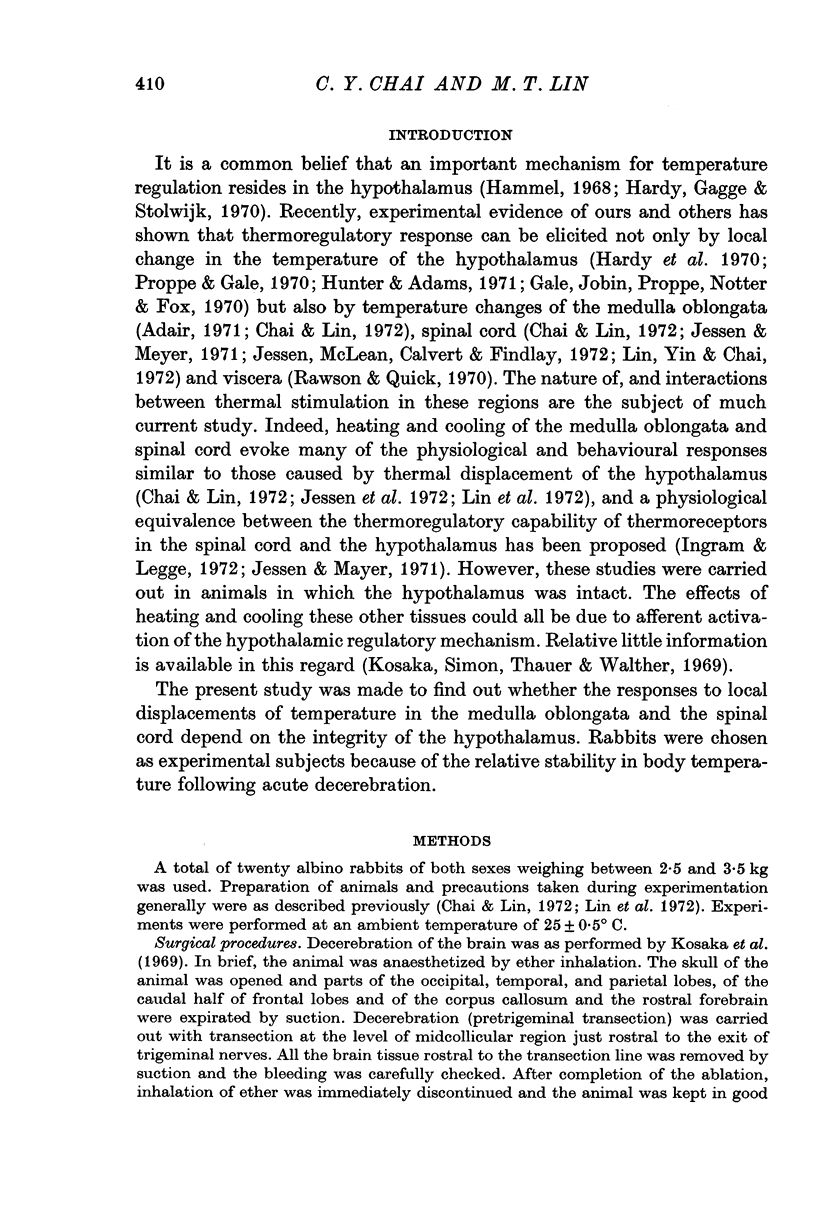

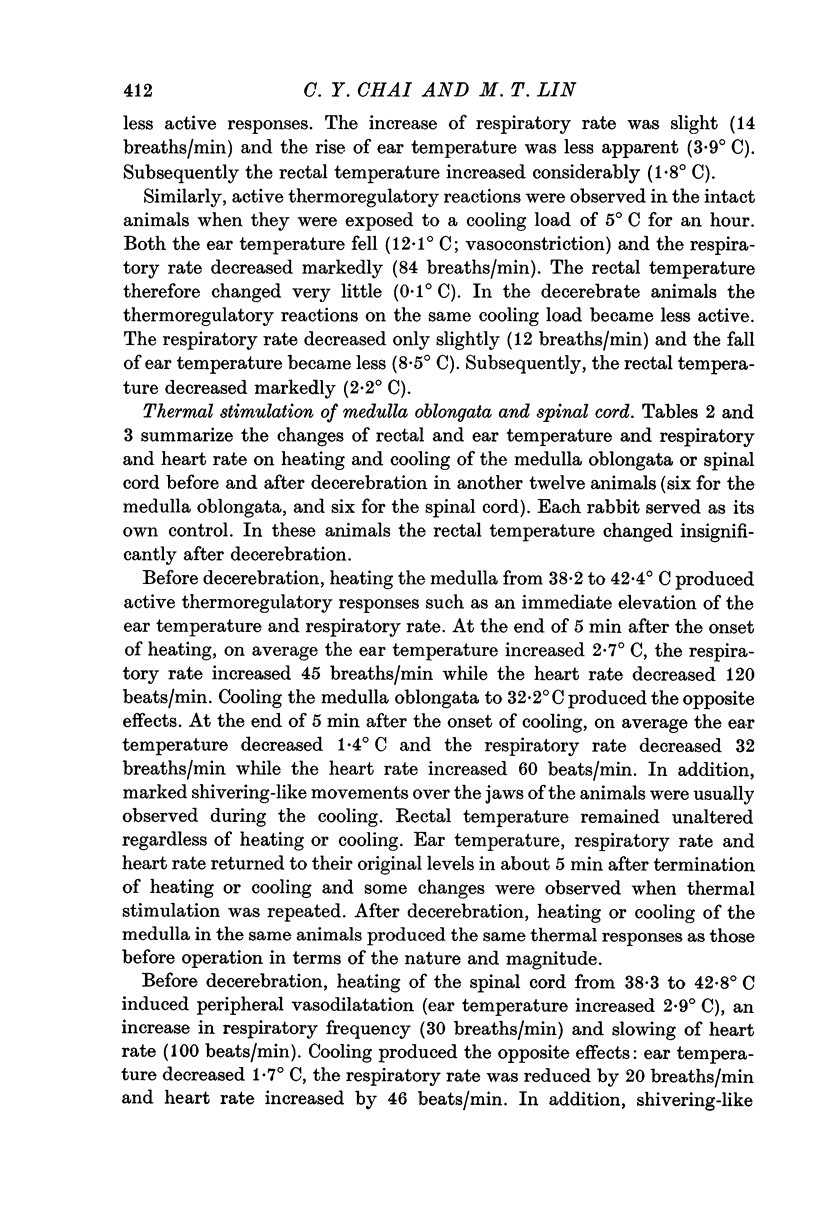



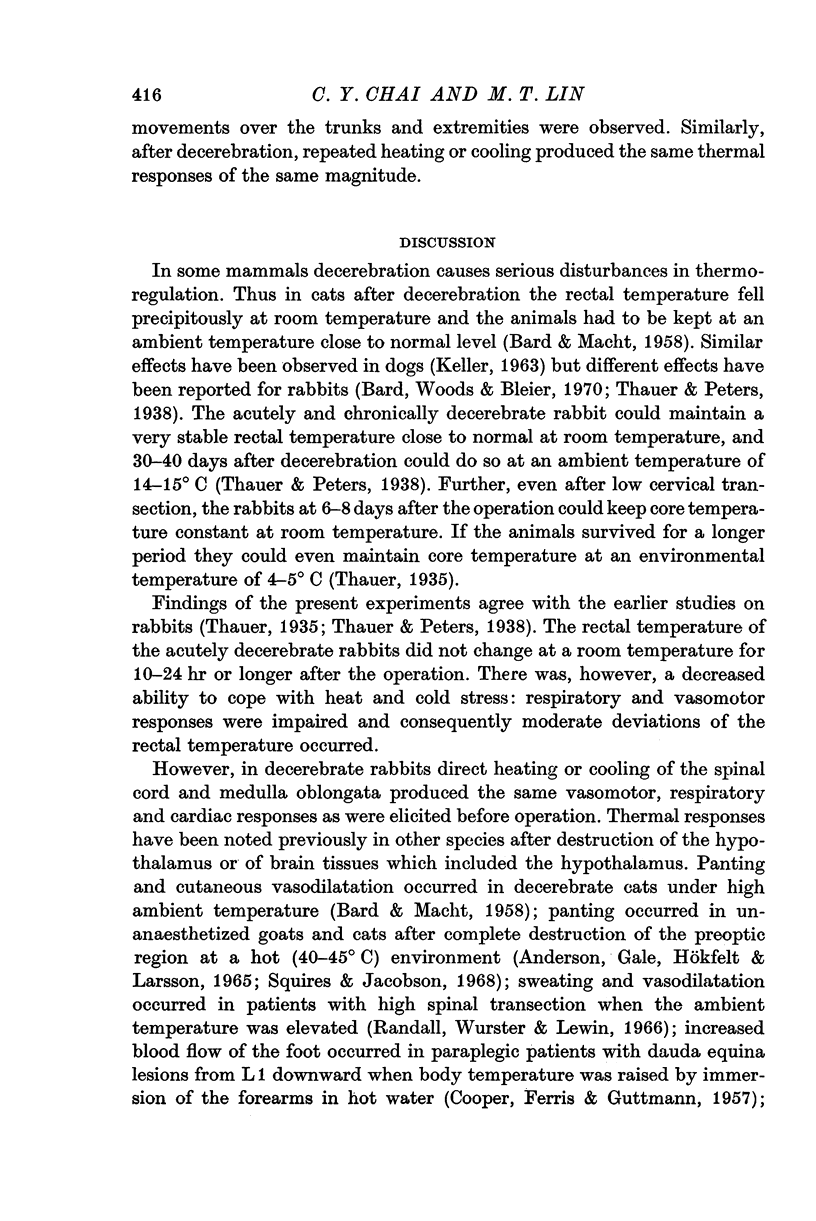
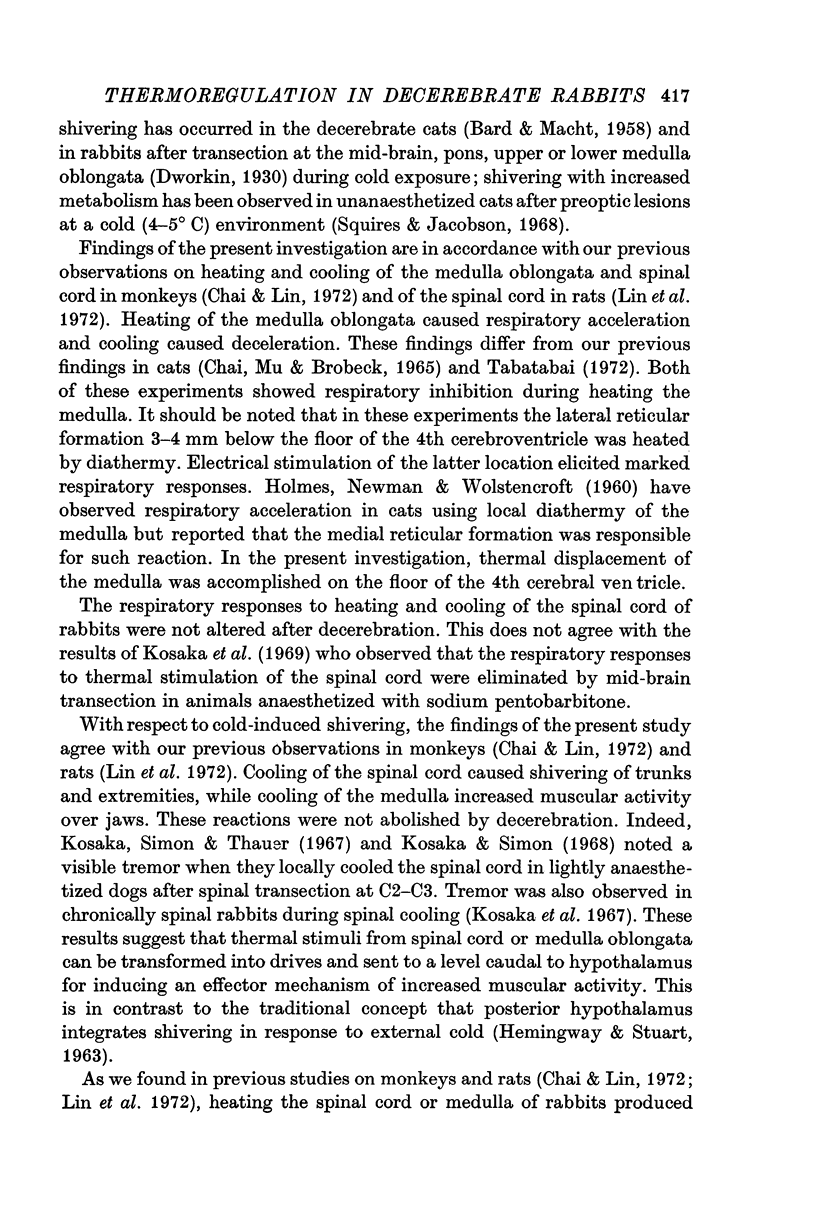

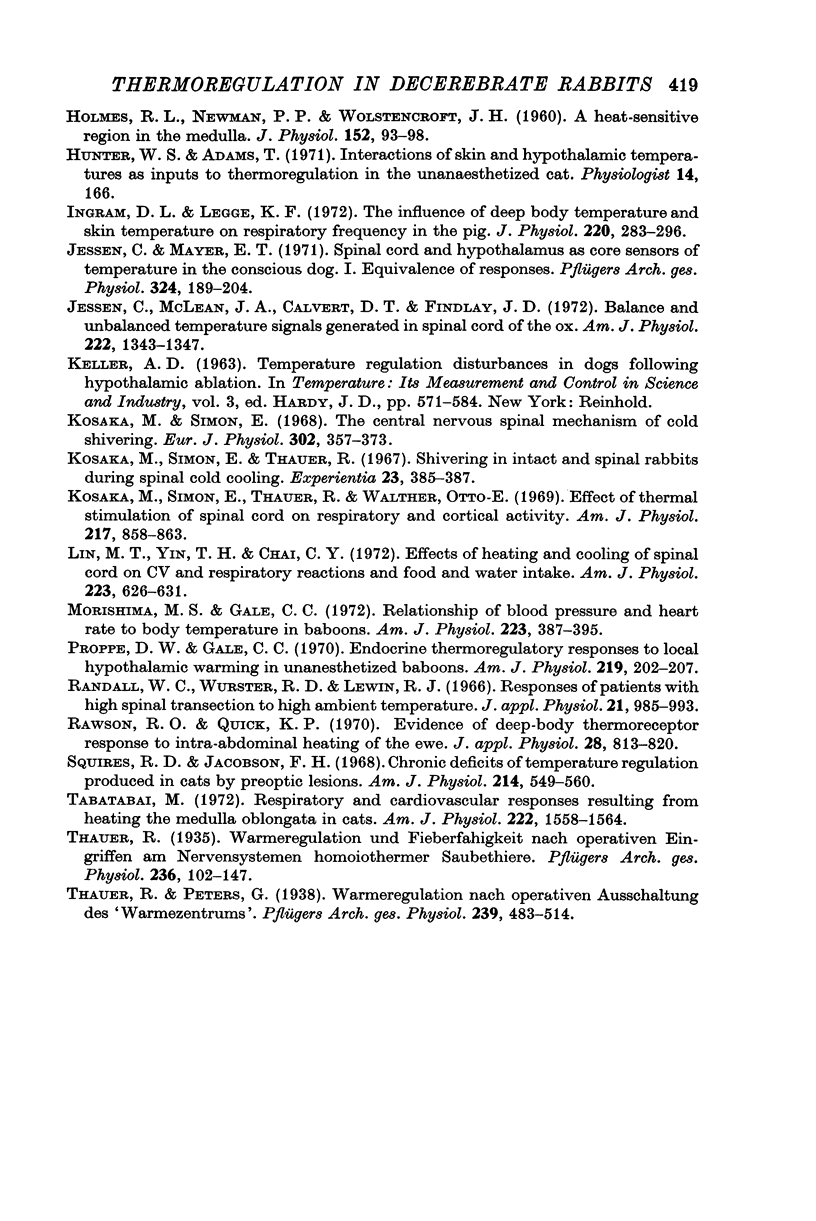
Selected References
These references are in PubMed. This may not be the complete list of references from this article.
- Adair E. R. Evaluation of some controller inputs to behavioral temperature regulation. Int J Biometeorol. 1971 Dec;15(2):121–125. doi: 10.1007/BF01803885. [DOI] [PubMed] [Google Scholar]
- COOPER K. E., FERRES H. M., GUTTMANN L. Vasomotor responses in the foot to raising body temperature in the paraplegic patient. J Physiol. 1957 May 23;136(3):547–555. doi: 10.1113/jphysiol.1957.sp005779. [DOI] [PMC free article] [PubMed] [Google Scholar]
- Chai C. Y., Lin M. T. Effects of heating and cooling the spinal cord and medulla oblongata on thermoregulation in monkeys. J Physiol. 1972 Sep;225(2):297–308. doi: 10.1113/jphysiol.1972.sp009941. [DOI] [PMC free article] [PubMed] [Google Scholar]
- Gale C. C., Jobin M., Proppe D. W., Notter D., Fox H. Endocrine thermoregulatory responses to local hypothalamic cooling in unanesthetized baboons. Am J Physiol. 1970 Jul;219(1):193–201. doi: 10.1152/ajplegacy.1970.219.1.193. [DOI] [PubMed] [Google Scholar]
- Hammel H. T. Regulation of internal body temperature. Annu Rev Physiol. 1968;30:641–710. doi: 10.1146/annurev.ph.30.030168.003233. [DOI] [PubMed] [Google Scholar]
- Ingram D. L., Legge K. F. The influence of deep body temperatures and skin temperatures on respiratory frequency in the pig. J Physiol. 1972 Jan;220(2):283–296. doi: 10.1113/jphysiol.1972.sp009707. [DOI] [PMC free article] [PubMed] [Google Scholar]
- Jessen C., Mayer E. T. Spinal cord and hypothalamus as core sensors of temperature in the conscious dog. I. Equivalence of responses. Pflugers Arch. 1971;324(3):189–204. doi: 10.1007/BF00586418. [DOI] [PubMed] [Google Scholar]
- Jessen C., McLean J. A., Calvert D. T., Findlay J. D. Balanced and unbalanced temperature signals generated in spinal cord of the ox. Am J Physiol. 1972 Jun;222(6):1343–1347. doi: 10.1152/ajplegacy.1972.222.6.1343. [DOI] [PubMed] [Google Scholar]
- Kosaka M., Simon E. Der zentralnervöse spinale Mechanismus des Kältezitterns. Pflugers Arch. 1968;302(4):357–373. doi: 10.1007/BF00592733. [DOI] [PubMed] [Google Scholar]
- Kosaka M., Simon E., Thauer R. Shivering in intact and spinal rabbits during spinal cord cooling. Experientia. 1967 May 15;23(5):385–387. doi: 10.1007/BF02144533. [DOI] [PubMed] [Google Scholar]
- Kosaka M., Simon E., Thauer R., Walther O. E. Effect of thermal stimulation of spinal cord on respiratory and cortical activity. Am J Physiol. 1969 Sep;217(3):858–864. doi: 10.1152/ajplegacy.1969.217.3.858. [DOI] [PubMed] [Google Scholar]
- Lin M. T., Yin T. H., Chai C. Y. Effects of heating and cooling of spinal cord on CV and respiratory responses and food and water intake. Am J Physiol. 1972 Sep;223(3):626–631. doi: 10.1152/ajplegacy.1972.223.3.626. [DOI] [PubMed] [Google Scholar]
- Morishima M. S., Gale C. C. Relationship of blood pressure and heart rate to body temperature in baboons. Am J Physiol. 1972 Aug;223(2):387–395. doi: 10.1152/ajplegacy.1972.223.2.387. [DOI] [PubMed] [Google Scholar]
- Proppe D. W., Gale C. C. Endocrine thermoregulatory responses to local hypothalamic warming in unanesthetized baboons. Am J Physiol. 1970 Jul;219(1):202–207. doi: 10.1152/ajplegacy.1970.219.1.202. [DOI] [PubMed] [Google Scholar]
- Randall W. C., Wurster R. D., Lewin R. J. Responses of patients with high spinal transection to high ambient temperatures. J Appl Physiol. 1966 May;21(3):985–993. doi: 10.1152/jappl.1966.21.3.985. [DOI] [PubMed] [Google Scholar]
- Rawson R. O., Quick K. P. Evidence of deep-body thermoreceptor response to intra-abdominal heating of the ewe. J Appl Physiol. 1970 Jun;28(6):813–820. doi: 10.1152/jappl.1970.28.6.813. [DOI] [PubMed] [Google Scholar]
- Tabatabai M. Respiratory and cardiovascular responses resulting from heating the medulla oblongata in cats. Am J Physiol. 1972 Jun;222(6):1558–1564. doi: 10.1152/ajplegacy.1972.222.6.1558. [DOI] [PubMed] [Google Scholar]


